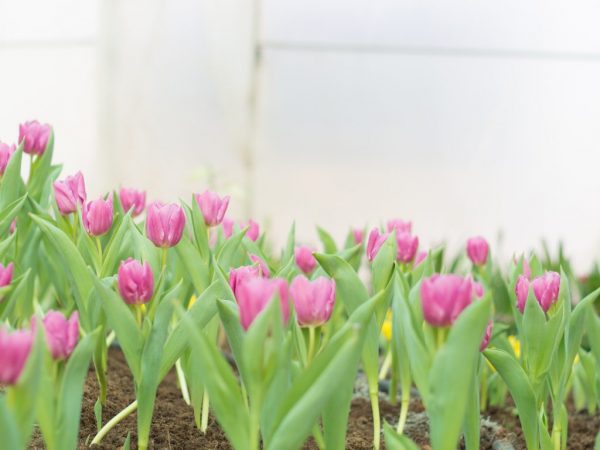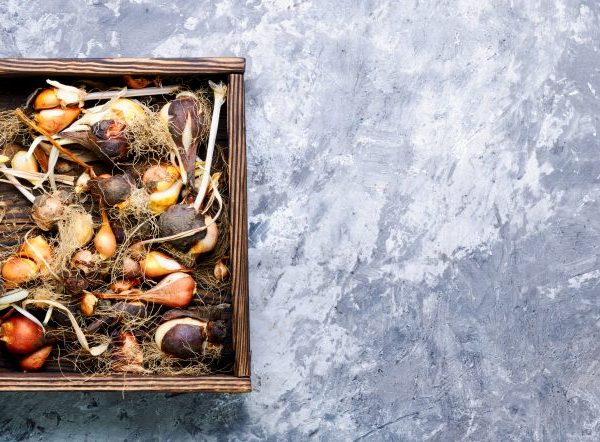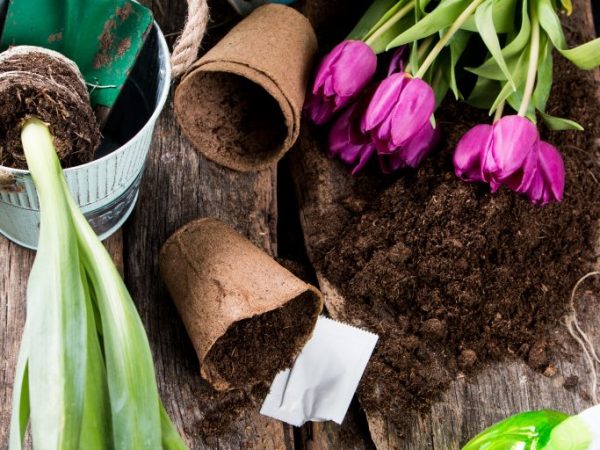Terms and rules for transplanting tulips
One of the most important steps in flower cultivation is transplanting. This procedure is performed with the aim of replacing the soil, improving the quality of flowering and rejecting rotten, dried out bulbs from healthy and strong ones. Transplanting tulips is a simple procedure, but it requires some knowledge and skills from the grower.

Terms and rules for transplanting tulips
Transplant timing
The timing of transplanting tulips is influenced by several factors: the climate and weather conditions in the growing region, the cultivar's agricultural technology and the state of the planting material.
For most growers, the most optimal period is from mid-September to mid-October. During this time, the plants will have time to take root in a new place before the onset of the first autumn frosts, and with the arrival of spring they will delight them with timely flowering.
You can transplant tubers not only in the fall, but also in the spring. The time is postponed if you missed the transplantation dates in the autumn. The very same spring transplant procedure is painful for plants, so you can expect them to bloom only next year.
Better to transplant tulips:
- a month before the expected first snowfall;
- in the regions of the Middle Lane, tubers can be dug up and transplanted in the second or third decade of October;
- when the plant has completely faded and began to turn yellow;
- after warming up the soil to a temperature of 10 ° at a depth of 10 cm.
The need for a transplant
It is necessary to transplant tulips in the following cases:
- the plant blooms poorly or does not form flower buds at all;
- in the presence of parasites in the soil, a poor composition and high acidity, tulips bloom, but ugly buds form on the stems;
- thickening of plantings, in which the plants become cramped and they suffer from a lack of nutrients and moisture;
- the need for plant propagation;
- in order to prevent the appearance of diseases and parasites;
- the need to plant healthy specimens from sick ones.
When not to transplant
Regardless of the variety, climatic conditions and the chosen timing, there are periods when it is prohibited to dig up and transplant these flowers:
- Tulips are not transplanted during flowering, because flowering plants do not tolerate this procedure well and may simply die.
- It is also not recommended to carry out this manipulation before flowering, which is fraught with the same consequences.
- You cannot move tulips to a new place when severe cold is on the doorstep. Plants simply do not have time to adapt and at the first frost they will freeze and die.
Transplant technique

Planting prepared tubers
Having decided on the timing of the procedure, you can proceed to the immediate implementation.
Preparation of planting material
It is necessary to dig up tubers in the summer - in the second or last decade of July.If you do this later, in August, the bulbs will have time to take root and they can no longer be disturbed, because after transplantation, there is a high probability of their death.
After digging, the bulbs are placed in a dark, well-ventilated room, free from dampness and drafts. The optimum storage temperature for bulbs is 20-23 °, the humidity level is not higher than 60%.
In the process of sorting healthy specimens from mechanically damaged or rotten ones, it is necessary to clean them from soil residues, dry scales and root processes. This must be done carefully so as not to damage the integrity of the tubers. You should also separate the planting material of different varieties separately.
Immediately before planting, the bulbs are disinfected - treated with garlic infusion, then with a solution of potassium permanganate.
Disembarkation at the site
You can transplant tulips in the spring into slightly acidic, organic-enriched, loose and light soil. Therefore, two weeks before transplanting, last year's manure or compost is applied to the site at the rate of 1 bucket per 1 sq. m. Then make a light digging and leveling. To deoxidize the soil, you will need dolomite flour, slaked lime or powdered chalk.
In the prepared area, holes are pulled out at a distance of 10 cm from each other, the same distance is maintained between the rows. The seeding depth of large tubers is 10-15 cm, of small ones - 6-8 cm.
In each hole, one tuber is lowered with a sprout to the top, sprinkled with earth and spilled abundantly with warm water. After planting, light leveling of the surface of the site is carried out using a rake.
Important! The same principle can be used to replant tulips in the spring.
Care rules

You can transplant tulips in the fall.
Further, the plants require careful and timely care in the open field in order for them to bloom and fully develop.
For warming for the winter, the tubers are slightly trampled, sprinkled with a mulch layer of sawdust or needles.
If the autumn has stood out without precipitation, before the onset of the first frost, the planting should be periodically moistened to eliminate the risk of drying out the bulbs. Watering too often can also harm young plantations. From an excess of moisture, they rot and disappear. Flowers experience the greatest need for moisture during the period of active flowering, therefore, the frequency and dose of water is increased.
As soon as the first sprouts appear, it is necessary to reject tubers that have not sprouted and specimens infected with diseases and parasites. This will prevent the risk of infection of healthy plants.
In order to increase the aeration of the soil and enrich the root system of plants with oxygen, regular loosening of the soil is carried out - one day after each watering or precipitation.
Top dressing
The main care of this flower involves regular feeding.
After the emergence of shoots, the soil is fertilized with nitrogen-containing preparations, which contribute to the intensive growth of shoots and leaves.
Until the moment of flowering, it is not necessary to fertilize tulips, although some gardeners apply complex mineral fertilizing once.
Re-feeding with nitrogen and phosphorus-potassium preparations is carried out during the budding period. The last feeding of decorative flowers is done after the end of flowering - phosphorus and potassium are added to increase the immunity and winter hardiness of plants.
The most common mistakes
Due to inexperience and lack of knowledge, novice flower growers often make irreparable mistakes in the process of growing these delicate flowers, as a result of which they wither and die:
- You can not transplant flowers during the active growing season, it is allowed to do this procedure only in emergency cases. Experienced flower growers recommend waiting for rest, after which you can safely move the plant to a new place.
- Moving into the flowering phase. You can transplant flowering tulips, but their survival rate in a new place is practically zero.The fact is that flowering specimens that successfully take root and endure wintering may not bloom next year.
- If by chance you managed to dig out a flowering plant from the soil along with a bulb, you should not plant it back into the ground, because after a while the flower will wither and die. Place the plant in a vessel with water, wait until the end of flowering, only after that it can be transplanted to another place.
- The bulbs should be stored in a cool place before the transplant procedure. In conditions of elevated temperatures from 25 to 30 °, the risk of deterioration and decay increases. The optimum temperature for keeping is 15-18 °.
Helpful hints
Some useful tips will help many growers avoid unpleasant consequences when transplanting these flowers:
- If you decide to transplant tulips in early spring, then the planting material must be placed in a container with cool soil and put in a basement or cellar for several weeks. This stratification procedure will increase the survival rate of tubers outdoors after planting.
- If possible, drying the bulbs before transplanting should be done outdoors, but without direct sunlight.
- In the process of transplanting, adult tubers should be sorted from their children and planted in different places, since they also have different flowering periods.
- Tulips can be dug up and planted along the daffodils. These flowers grow very well and blend with each other. Tulips bloom immediately after the daffodils have faded.
Conclusion
Tulips can be transplanted not only in autumn but also in spring. Subject to all the rules for the preparation of planting material, its correct planting and further care, you can get healthy, strong and beautiful flowers on your site, which will delight you with their bright beauty for a long time.


